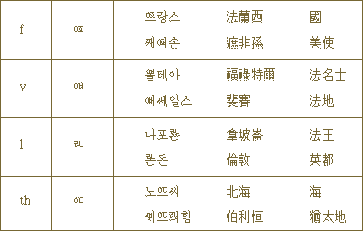In this table writings for
‘f, v, l, th’ attract our attention.

This table has many other interesting points.
As the present author has no time to discuss them
in detail, he would like to carry it over, for
another opportunity. Among the above examples,
there appeared an interesting one for Versailles,
the city to the west of Paris, Chinese characters
‘裴賽’ reflected English pronunciation [ve:sai];
Hangeul letters ‘ㅇㅂㅓ 쎄일스’, American pronunciation
[verseilz].
The trend to use special letters or some combinations
of letters for writing loanwords continued on
into the 20th century. ?Mod?n Chos?n woeraeo Saj?n?(모던
朝鮮 外來語 辭典, Modern Korean Dictionary for Loanwords,
1937) by Lee Chong-G?k, shows good examples collected
from various publications at that time. The representative
supporter for this trend with a theoretical basis
was ?Hangeul-gal?(한글갈, A Thesis On Hangeul, 1942)
by Choi Hy?n-Bae. Shortly after the independence
of Korea, as chair of the Board of Editing Textbooks
in The Ministry of Culture and Education, he included
his own insistence in <T?ron mal Ch?ngn?n P?b>(들온
말 적는 법, Writing Method of Loanwords, 1948). [f]
ㆄ, [v] ?,
[l] ?, [z] [ ] ?, etc. ?
However, The Linguistic Society of Chos?n already
fixed the principle that in writing loanwords
new letters or symbols could not be introduced
in chapter 6 of A Unified Proposal of Hangeul
Orthography, and A Unified Proposal of Writing
Loanwords, decided in 1940 and publicized in 1942,
followed this principle. Thus, they made it a
norm to write ‘ㅍ’ for [p] and [f], ‘ㅂ’ for [b]
and [v], ‘ㄹ’ for [l] and [r], and ‘ㅈ’ for [z]
and [d?] without any discrimination. 9)
As we saw above, the personal
opinion of Choi Hyon-Bae's (1942), different from
the principle of The Linguistic Society of Chos?n(한글학회),
was decided as the official opinion of The Ministry
of Culture and Education in 1948. But, it returned
to the principle that only the existing twenty-four
letters must be used in writing loanwords, in
A Writing Regulation for Roman Alphabet with Hangeul(로마자의
한글화 표기법) publicly announced in 1958. A Writing
Norm for Loanwords(외래어 표기법) made publicly in 1986,
persisted in this principle too.
Thus, it is really fortunate that no new letters
for loan words were added. If the addition of
new letters should be permitted for original pronunciation
of foreign words, as was already pointed out by
Kim Min-Su (1973:110), “we should prepare as many
Korean letters as the number of all phonemes of
all languages in the world in order to write ‘the
precise pronunciations’ of foreign words.” This
preposterous statement is due to the false conception
of loan words. Loan words are a part of Korean
vocabulary, and are naturally to be written as
pronounced in the Korean language.
|



